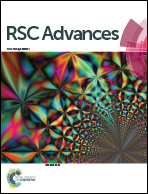A ratiometric fluorescence sensor for HOCl based on a FRET platform and application in living cells†
Abstract
Studies showed that the intravascular pH of neutrophils fell to 4.5–5.0 with stimulation for a few minutes. Under this condition, myeloperoxidase was activated to catalyze H2O2 and Cl− to form hypochlorous acid (HOCl). Therefore, it is of significance to develop fluorescence probes for sensing HOCl in acid conditions. In this work, we reported a ratiometric probe CRSH based on a fluorescence resonance energy transfer (FRET) platform for detecting HOCl under acid conditions. Probe CRSH exhibited excellent sensitivity, high selectivity and a rapid response toward HOCl and is suitable for imaging endogenous HOCl in living cells.


 Please wait while we load your content...
Please wait while we load your content...